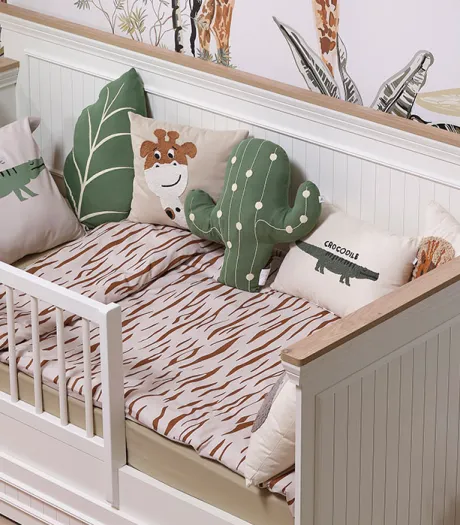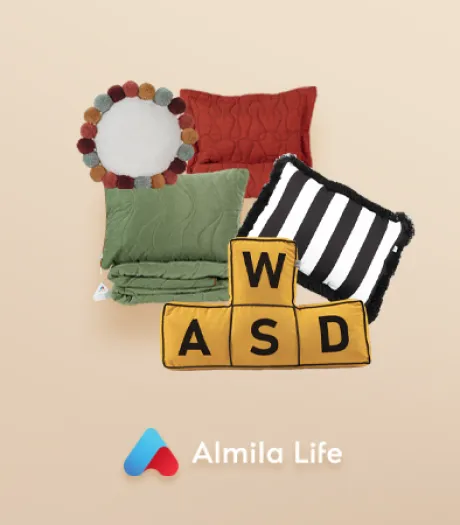
Children live a life intertwined with colors from the moment they start exploring the world. Colors, which have a great impact on their development and mood, are also of great importance in their rooms, one of the areas where they will spend the most time. Therefore, both aesthetic and psychological effects should be taken into consideration when determining children's room colors.
One of the topics that parents are most curious about is which colors can positively affect their children's mood. Making the right choice, especially when determining boy's room paint colors or girl's room colors, contributes to their healthy development process.
How Should Children's Room Colors Be Chosen?
Knowing how the colors to be used in the children's room affect their energy, creativity and peace provides a great advantage. Although the psychological effects of colors have not been scientifically determined, observations and research conducted for many years show that some colors directly affect children's moods. Points to consider when choosing children's room colors:
- Your child's age: Softer and more peaceful colors are preferred for babies and young children, while dynamic and vibrant colors can be chosen for older children.
- Gender and personal preferences: Boys and girls may have different tastes in color. However, going beyond the classic perception of blue and pink can help you create more creative spaces.
- Psychological effects of colors: Some colors are energizing while others have a calming effect.
By considering all these factors, you can make the right decision in the nursery painting process.

Color Selection for Girls' Room
Girls' room colors should be chosen from calming and inspiring tones that develop the child's imagination. The most preferred color combinations are as follows:
- Lilac and yellow: While lilac color develops imagination, yellow creates an energetic atmosphere in the room.
- Green and pink: While green supports mental clarity, pink creates a warm environment.
- Pastel tones: Soft colors such as light pink, salmon, lavender create a more peaceful atmosphere.
In girls' rooms, it is important that the furniture and accessories are compatible as well as the wall color. At this stage, you can strengthen the general ambiance of the room with the furniture that offers aesthetics and functionality together as the Almila family.
Color Selection for Boys' Room
Boys' room paint colors are usually chosen from stronger and more vibrant tones. The most preferred colors are as follows:
- Blue and orange: While blue provides calmness and serenity, orange creates an energetic balance.
- Red and green: Red symbolizes courage and passion, but when used too much, it can create aggression. When balanced with green, it provides mental relaxation.
- Gray and yellow: It is a great combination for those who want to create a modern and stylish room.
It is also important to match the furniture and carpets when choosing a child's room wall paint.

Color Selection for a Youth Room
When determining a room color for young people, it is necessary to give importance to their individual preferences. Colors are quite critical in terms of expressing personality during adolescence. The best options can be listed as follows:
- Earth tones: Creates a warm and comfortable atmosphere in harmony with wooden furniture.
- White and navy blue: A modern and stylish combination, making the room look larger and more spacious.
- Black and gray: It can be an ideal choice especially for young people who like minimalist decoration.
The important thing here is to ensure that young people see their rooms as a personal space. For this, it is a good method to get their ideas and design the room together.
Things to Consider When Choosing a Color for Painting a Children's Room
When painting a children's room, not only the color selection but also the type of paint is very important. There are some points to consider when choosing paint for children's rooms.
- Water-based paints that are harmless to health should be preferred.
- Erasable paints ensure that the walls remain clean for a long time.
- You can prefer semi-matte or satin paints instead of matte. Semi-matte and satin paints reflect light better and make the room look more spacious.
By paying attention to these elements, you can achieve the best result in choosing a child's room wall paint.
When determining the child's room colors, not only aesthetic elements but also psychological effects should be taken into account. You can create a comfortable and supportive living space by choosing colors that are appropriate for the child's age, personal preferences and the general atmosphere of the room. In addition, choosing paints that are harmless to health, durable and wipeable will provide advantages in terms of both hygiene and ease of use in the long run.
Softer and more peaceful tones are recommended especially for baby rooms. For more detailed information on this subject, you can review our blog post titled What Are Baby Room Colors and How Should They Be?






































